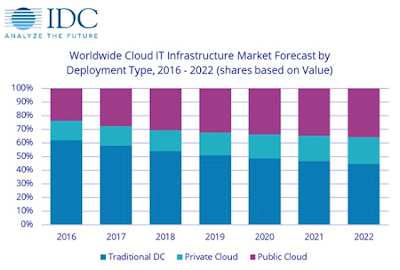
Vendor revenue from sales of infrastructure products — server, storage, and Ethernet switch — for cloud IT grew by 45.5 percent year-over-year in the first quarter of 2018 (1Q18), reaching $12.9 billion according to the latest worldwide market study by International Data Corporation (IDC).
IDC also raised its forecast for total spending on cloud IT infrastructure in 2018 to $57.2 billion with year-over-year growth of 21.3 percent. Let's consider the key trends that are driving this phenomena. What really matters most, going forward?
Cloud infrastructure market development
Public cloud infrastructure quarterly revenue has more than doubled in the past three years to $9 billion in 1Q18, growing 55.8 percent year-over -year. Private cloud revenue reached $3.9 billion for an annual increase of 26.5 percent.
The combined public and private cloud revenues now represent 46.1 percent of the total worldwide IT infrastructure spending, up from 41.8 percent a year ago. Traditional (non-cloud) IT infrastructure revenue grew 22 percent from a year ago, although it's declined over the past several years — at $15.1 billion in 1Q18 it still represents 53.9 percent of total worldwide IT infrastructure spending.
"Hyperscaler datacenter expansion and refresh continued to drive overall cloud IT infrastructure growth in the first quarter," said Kuba Stolarski, research director at IDC. "While all infrastructure segments continued their strong growth, public cloud has been growing the most."
IDC expects this trend to continue through the end of 2018. Digital transformation initiatives such as edge computing and machine learning have been bringing new enterprise workloads into the cloud, driving up the demand for higher density configurations of cores, memory, and storage.
As systems technology continues to evolve towards pooled resources and composable infrastructure, the emergence of these next-generation workloads will drive net new growth beyond traditional enterprise workloads.
All regions grew their cloud IT Infrastructure revenue by double digits in 1Q18. Asia-Pacific (excluding Japan) grew revenue the fastest, by 74.7 percent year-over-year.
Next were the U.S. market (43.6 percent), Middle East & Africa (42.3 percent), Central and Eastern Europe (39.2 percent), Latin America (37.7 percent), Canada (29.4 percent), Western Europe (26.1 percent), and Japan (15 percent).
IDC's cloud IT infrastructure forecast measures total spend (vendor recognized revenue plus channel revenue). Of the $57.2 billion in cloud IT infrastructure spend forecast for 2018, public cloud will account for 67 percent of the total, growing at an annual rate of 23.6 percent. Private cloud will grow at 16.7 percent year-over-year.
That said, worldwide spending on traditional 'non-cloud' IT infrastructure is expected to grow by just 4.2 percent in 2018 as enterprises continue to refresh their legacy platforms. Traditional IT infrastructure will account for 54 percent of total end user spending on IT infrastructure products — that's down from 57.8 percent in 2017.
Outlook for cloud computing growth
This represents a decelerating share loss as compared to the previous four years. Moreover, the growing share of cloud environments in overall spending on IT infrastructure is common across all regions.
Long-term, IDC expects spending on cloud IT infrastructure to grow at a five-year compound annual growth rate (CAGR) of 10.5 percent — reaching $77.7 billion in 2022, and accounting for 55.4 percent of total IT infrastructure spend.
Public cloud datacenters will account for 64.7 percent of this amount, growing at a 10.2 percent CAGR. Spending on private cloud infrastructure will grow at a CAGR of 11.1 percent.
Some analysts already believe that it doesn't matter who leads the cloud infrastructure market, since it's essentially a commodity business with rapidly shrinking profit margins. So, what does really matter? Which vendors are best positioned to champion and lead the 'Optimal Hybrid Cloud' environment?
